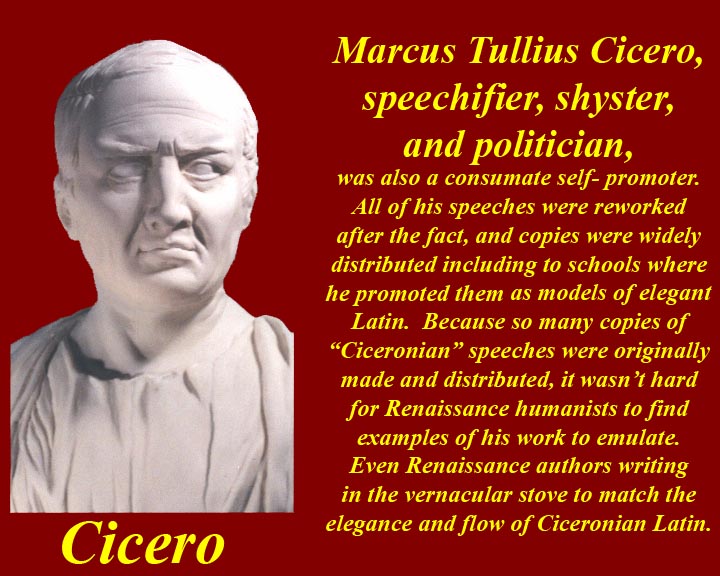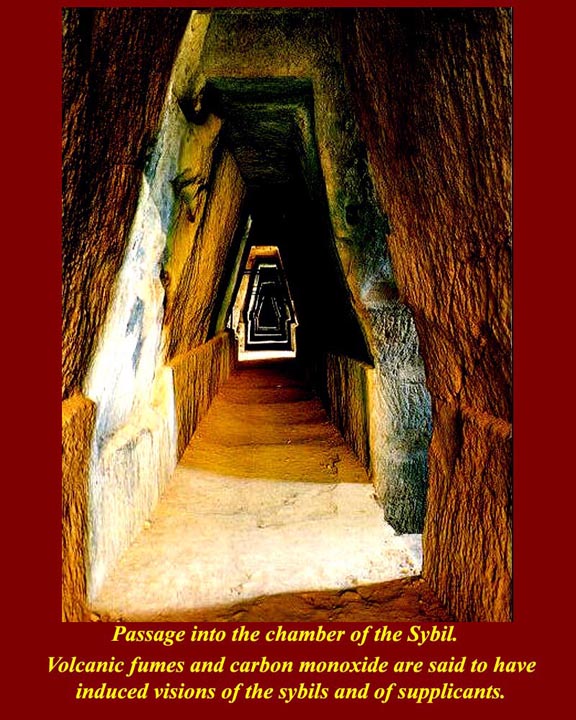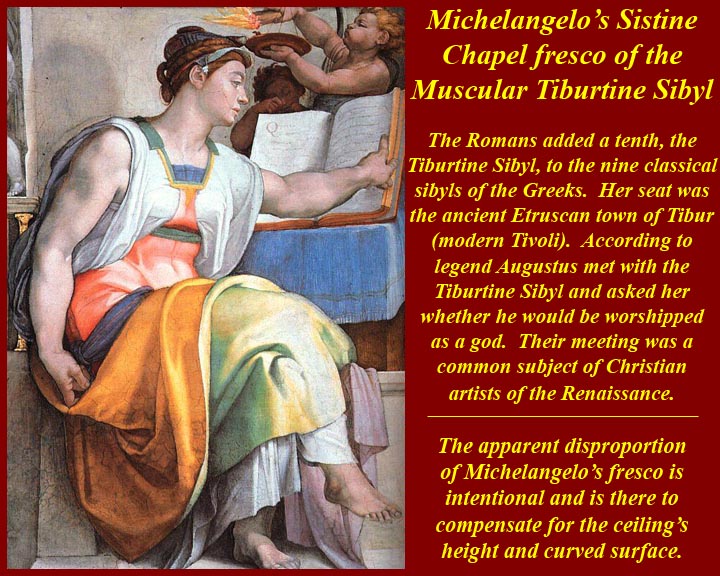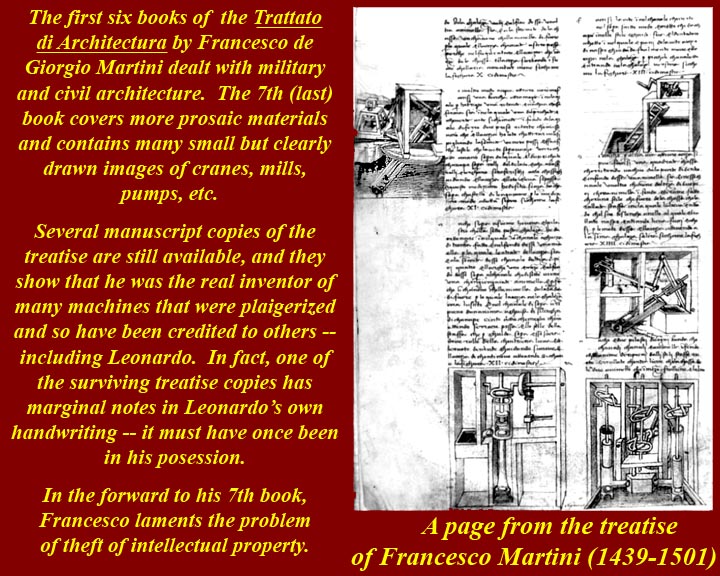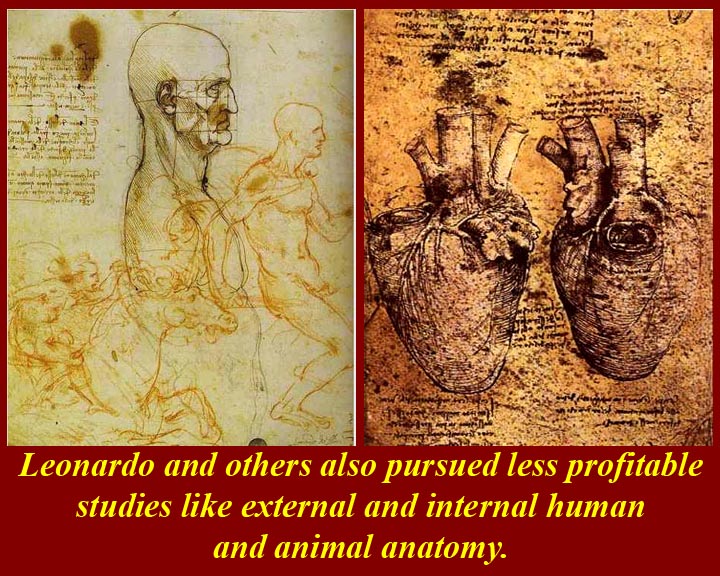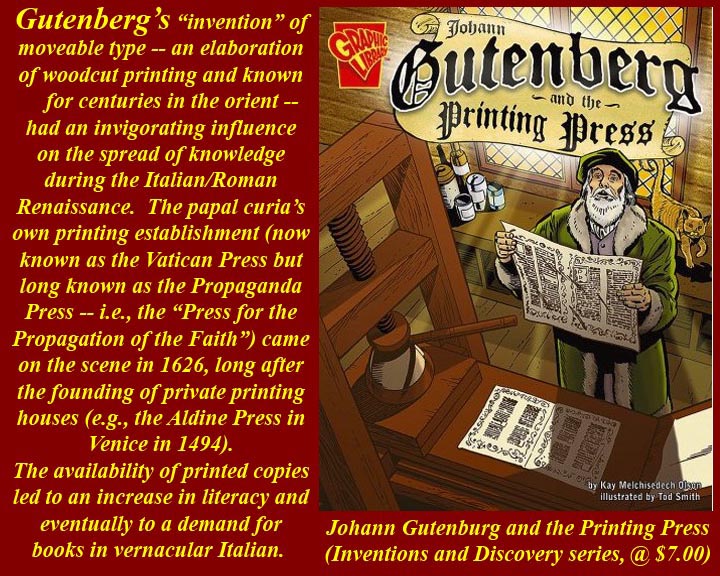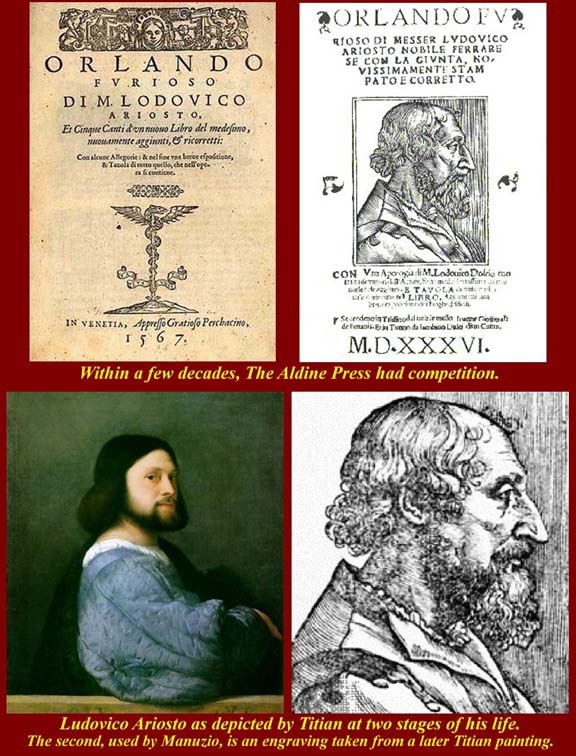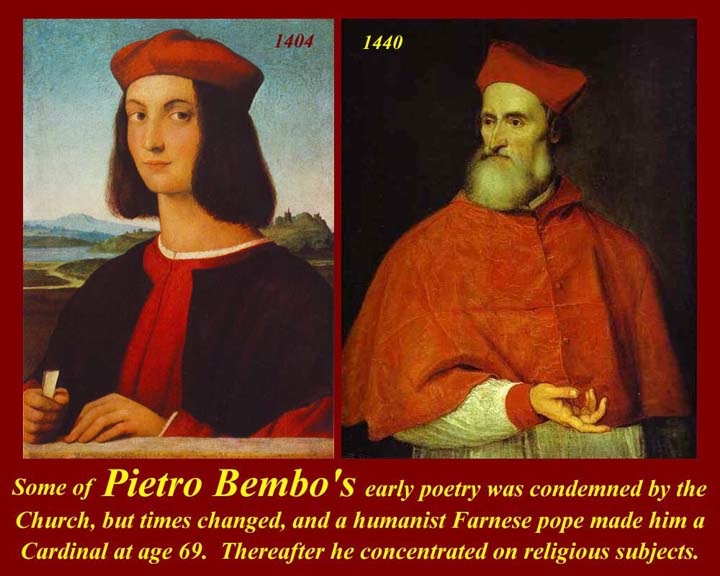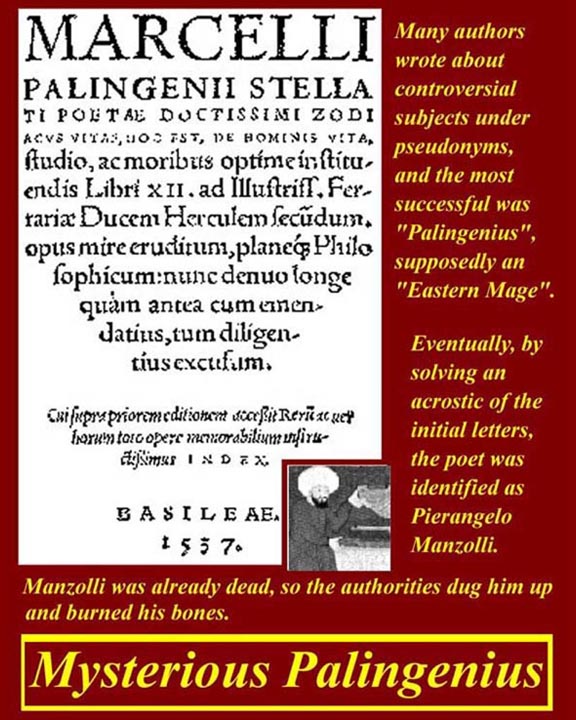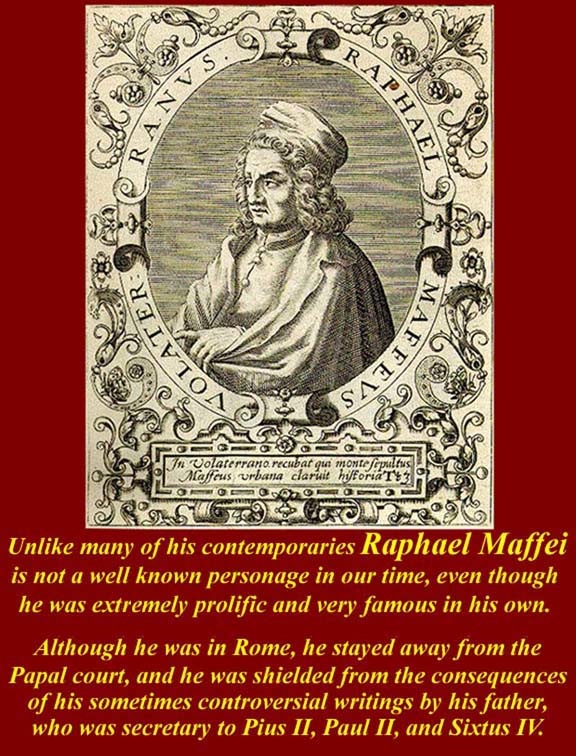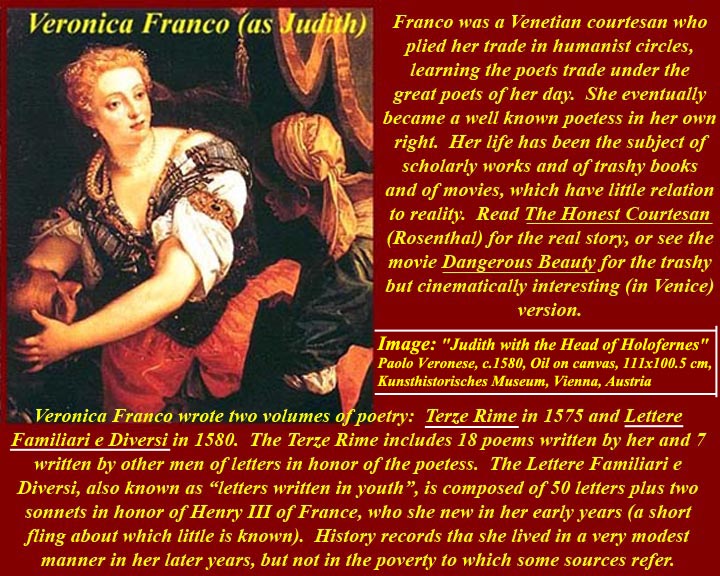Roman Renaissance and Literature
Click on links or small images below to go to larger images for Unit 5.
Classical sources added to biblical and patristic sources
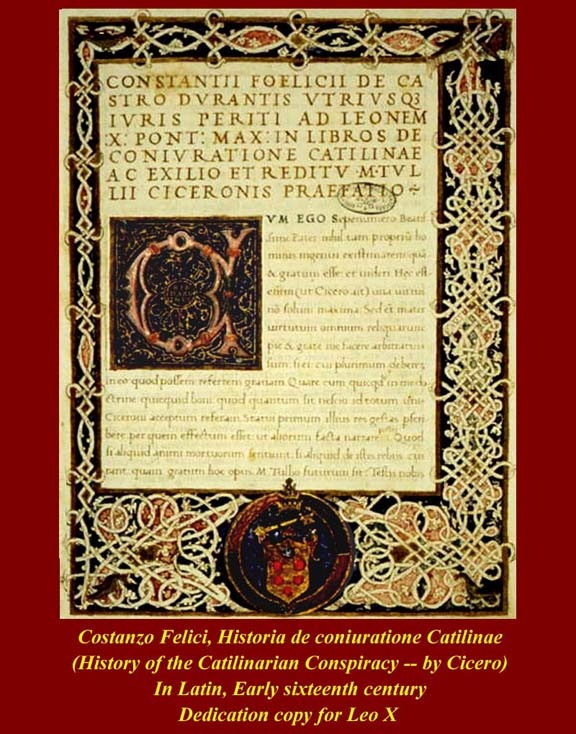
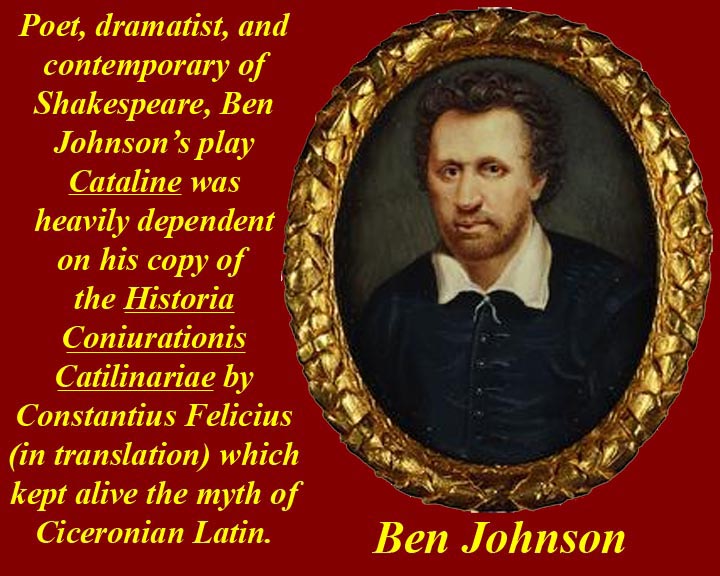
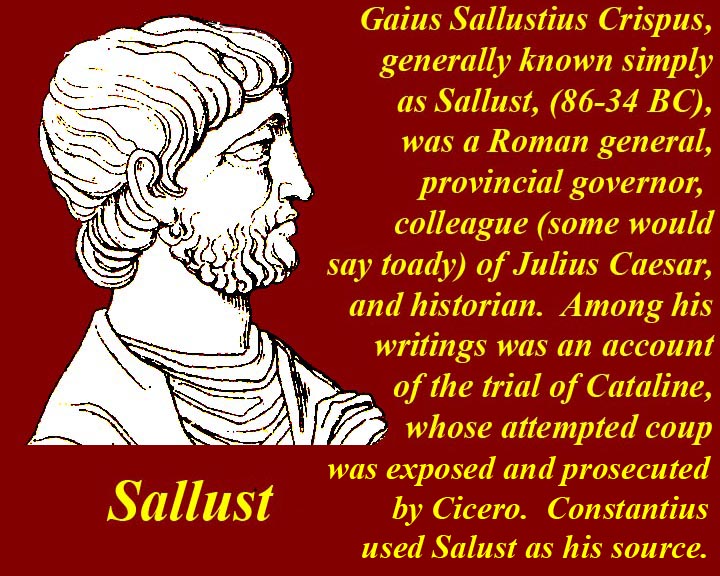
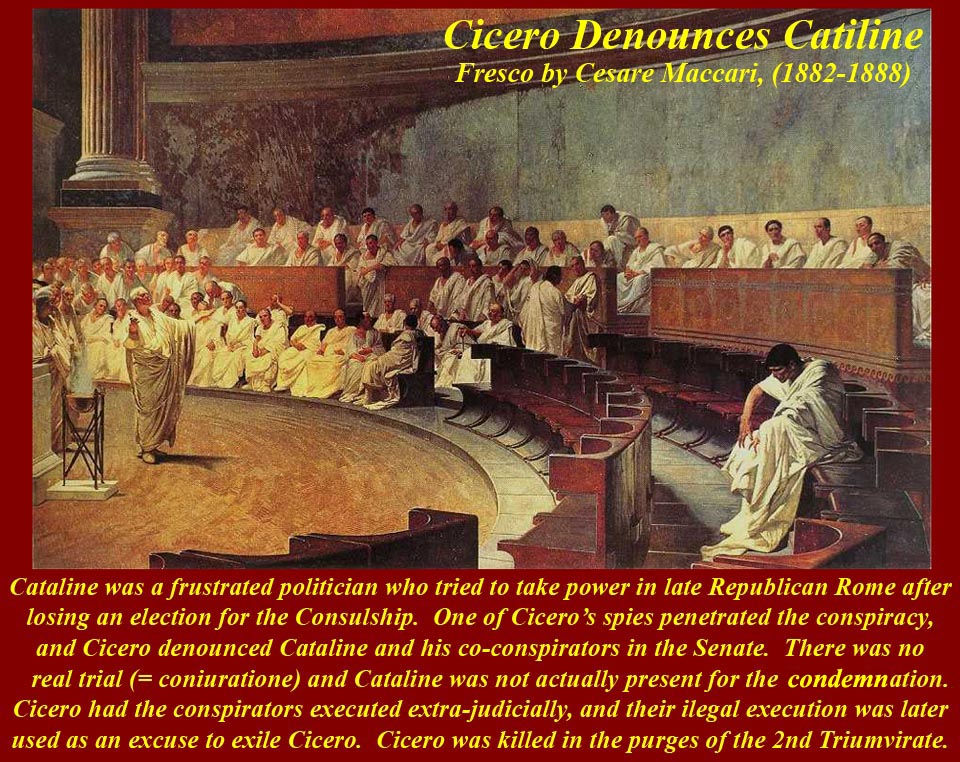
http://www.mmdtkw.org/RenRom0501-FeliciCiceroCata.jpg
http://www.mmdtkw.org/RenRom0501a-CiceroCatalineDenunciation.jpg
http://www.mmdtkw.org/Renrom0501b-Sallust.jpg
http://www.mmdtkw.org/RenRom0501c-CiceroCatalineMaccari-.jpg
http://www.mmdtkw.org/RenRom0501d-Cicero.jpg
Scholarship, before the arrival of humanist philologists (from Greek: philo=love [of the] logos=word), had concentrated on biblical and patristic sources ("patristic" meaning the works of the Greek and Latin "Fathers of the Church"). The humanists added classical Roman and Greek materials to the scholarly repertoire -- and Latin source materials dominated their initial efforts. Because Ciceronian Latin was considered the best and most elegant form of the language, there was a natural emphasis on ancient materials about Cicero himself. That's what was at work here with an account by "Constantius Felicius" of the prosecution by Cicero of Cataline, a failed coup-plotter, drawn from an earlier account of the same prosecution, which had been written by Cicero's contemporary, the historian Sallust. Constantio Felici, of course, emulated Cicero's own elegant Latin style -- Felici, in the style of his own humanist circle, even gave himself an elegant Latin name.
There is, of course, a circularity in "Ciceronianism", and it started with Cicero himself. Cicero was a notorious self promoter -- and a pompous speechifier, a shyster lawyer, and an ambitious politician. The reasons, during the Renaissance, for the availability, popularity, and respect for Cicero's highly rhetorical speeches and court appearances (prosecution and defense) and of his written works were that (a) he and his assistant, Tiro, re-edited after delivery his every public utterance to make sure it was elegant and error free (kind of like what our legislators do for the Congressional Record, but they do it less skillfully), and (b) he bought large runs of manuscript copies of his rhetorical and written output, and he distributed them to major centers around the Roman hegemony. He also gave copies to Roman grammar schools thus ensuring that they would be studied and copied by students. Cicero's own widespread distribution system and the existence of large initial numbers of copies made it inevitable that more copies of Ciceronian works would survive into the Renaissance period than copies of the speeches or works of other people. It would then also be inevitable that the starry-eyed humanists would think that the plethora of "Ciceronian" documentation that had survived and which the humanists were able to recover reflected an actual ancient Roman preference for Ciceronian Latin rather than being a reflection of Cicero's self promotion. The "Ciceronian" humanists may, in fact, have been correct; Ancient Rome really may have had great respect for Cicero's Latin and may have considered it as Latin's most elegant form -- certainly, rhetoricians who followed Cicero copied his style. But something else might also be at work here: Renaissance "language snobs" falling in line behind Ancient Roman rhetors of the same ilk.
Cicero's end: After delivering his Philippics -- speeches against Mark Antony -- Cicero witnessed and then felt the burden of the temporary alliance of Octavian (Augustus), Antony, and Lepidus in the Second Triumvirate. The Triumvirate initiated immediate purges, and Antony put Cicero's name on the proscription list. Cicero fled, but bounty hunters caught up with him on his way to his refuge/villa in Ostia. They brought his head and hands back to Rome where they were displayed and defiled on the rostrum in the city's Republican Forum.
We are no less guilty of language snobbery. We revere, but we seldom, if ever, use, Shakespearean English and "the King's English" (i.e., the English of the King James Bible).
Sibylline prophecies made equal to biblical prophecies
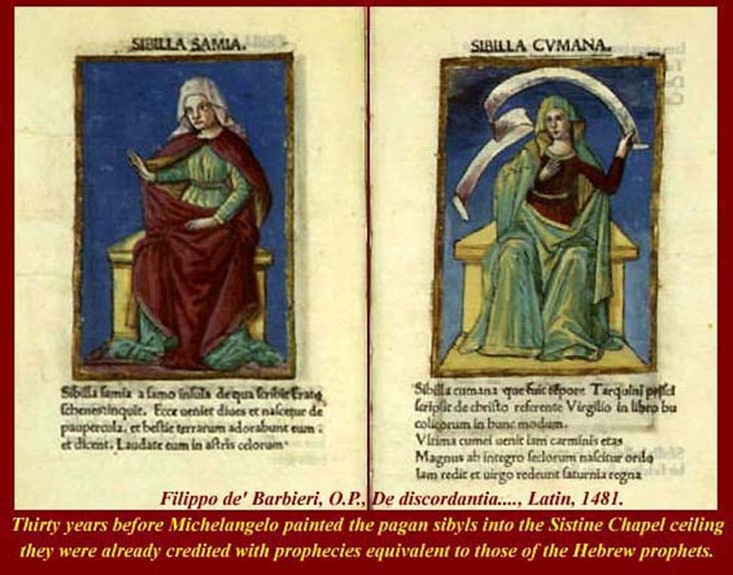
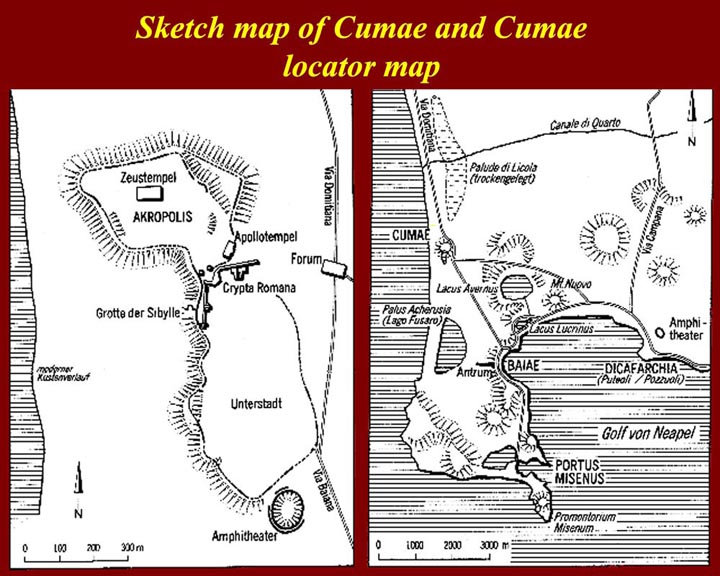
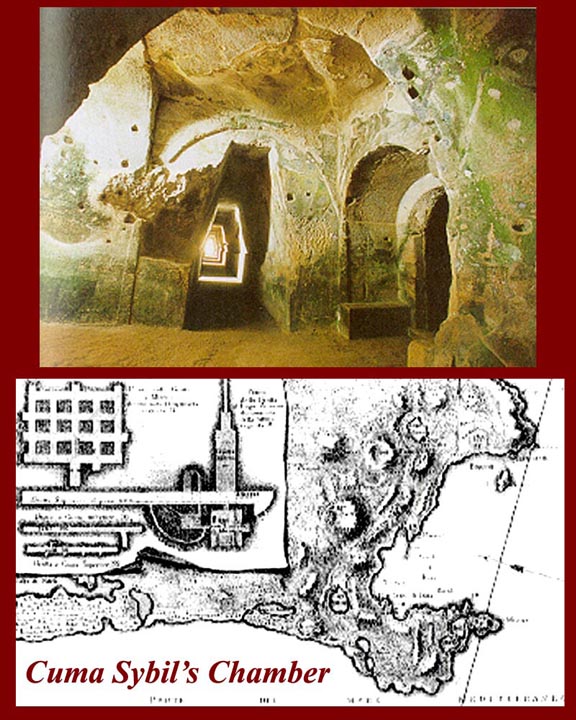
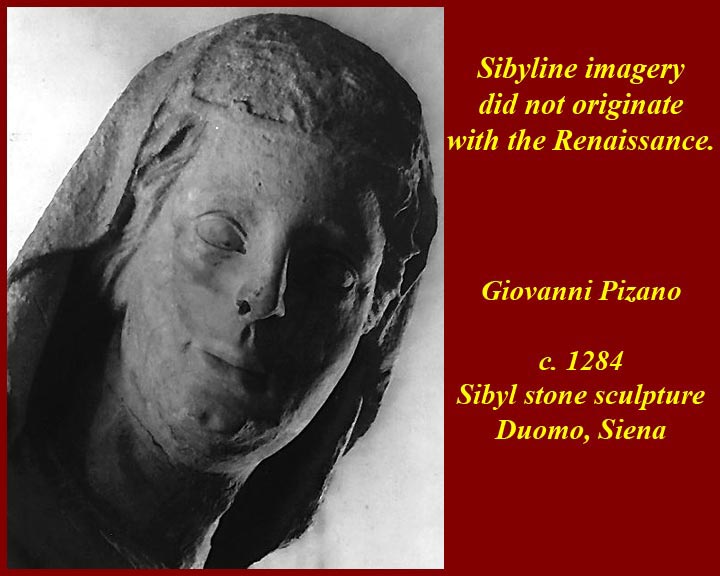
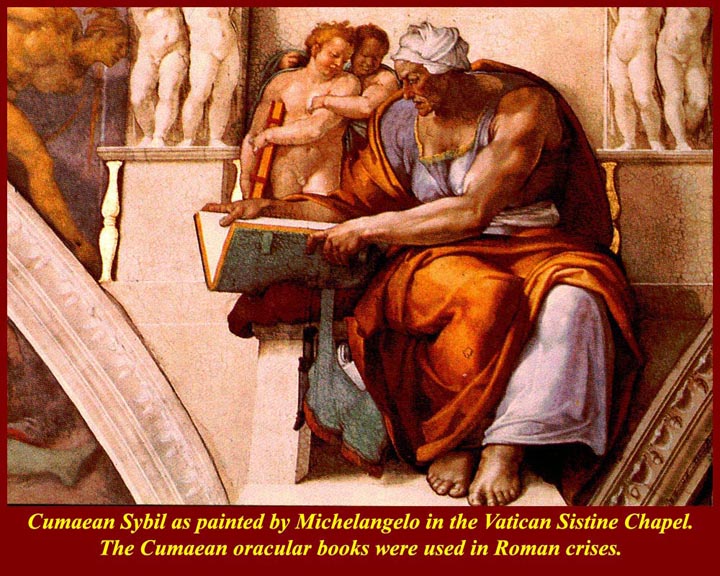
http://www.mmdtkw.org/RenRom0502-SibylineProphecy.jpg
http://www.mmdtkw.org/RenRom0502a-CumaeMaps.jpg
http://www.mmdtkw.org/RenRom0502b-CumaeSybilChamber.jpg
http://www.mmdtkw.org/RenRom0502c-CumaeSybilCave.jpg
http://www.mmdtkw.org/RenRom0502d-SienaDuomoSibyl.jpg
http://www.mmdtkw.org/RenRom0502e-CumaeSybilMichelangelo.jpg
http://www.mmdtkw.org/RenRom0502f-TiburtineSybil.jpg
As we noted in the last unit, the ancient Greek and Roman Sibyls were enshrined in Roman Renaissance art. But their supposed prophecies were also the subject of Renaissance humanist exegesis. The word "supposed" in the previous sentence is double-barreled: first you have to believe in their ability to prophesy at all and then you have to believe the provenance of the texts and glosses used by the humanists.
The story of the acquisition of the Sibylline Books by King Tarquinius is one of the famous mythic elements of Roman history. The Cumaean Sibyl (a Greek "colonial" Sibyl) offered to sell nine books of these prophecies to Tarquinius. He declined to purchase them, owing to the exorbitant price she demanded, so she burned three and offered the remaining six to Tarquinius at the same stiff price, which he again refused. She burned three more and repeated her offer. Tarquinius then relented and purchased the last three at the full original price and had them preserved in a vault beneath the temple of Jupiter Capitolinus. The books, however, were lost when the Temple burned in 83 BC, and, a few years later, envoys were sent out to collect "similar sayings" from Mediterranean oracular sites and from the local (as opposed to Greek) Sibyl at Tiburtina (modern Tivoli). She was being puffed by the Marcii clan that came from Tiburtina. "Experts" said the new set of oracular sayings matched up pretty well with the old set, so those collected prophecies became the Sibylline books. Those "new" books were finally burned by order of the Roman General Flavius Stilicho (365-408 C.E.). There were, of course, forgeries over the centuries, and the provenance of the prophecies discovered by the Renaissance humanists was more than extremely shaky. None of the "original" Sibylline books (or even any pages of them) ever surfaced; what the humanists had were supposed accounts of what ancient Romans did as a result of certain prophecies to which were attached paraphrases of what the prophecies were thought to have meant -- sorta, kinda, almost, just about.
So the humanists were on very shaky ground in their own interpretations of medieval interpretations of ancient Roman interpretations of even more ancient Greek interpretations of what the obscure and cryptic words of the Sibyls might mean. (Any deviation of what really happened after an interpretation was always due to an interpreter problem -- what today would be called an operator error.) But the humanist commentaries on prophecies could be relied upon to be "politically correct". All the ancient prophecies, whether by Biblical or by Sibylline prophets, were interpreted by the Italian Renaissance humanists, and particularly by those humanists in the papal Curia, as proving (a) the primacy of Christianity among religions, (b) the primacy of Peter among the Apostles, and therefore (c) the primacy of the Popes (and by extension the Papal bureaucracy) among possible other claimants, e.g., various patriarchs, bishops, emperors, monarchs, and any other possible authority figures, and, finally, (d) that the center of religious and secular authority rightly resided in Rome.
Did I say "finally"? After the Reformation, the same prophetic evidence proved that Catholicism trumped Protestantism. At least it did in Rome. There were Protestant interpretations that said otherwise.
For information on the Sibylline Books, see http://en.wikipedia.org/wiki/Sibylline_Books and http://www.newadvent.org/cathen/13770a.htm and on the Pseudo-Sibylline oracles -- the supposed but clearly forged ancient texts -- see http://www.sacred-texts.com/cla/sib/ where you can find Milton S. Terry's 1899 English translations and at http://www.earlychristianwritings.com/sibylline.html.
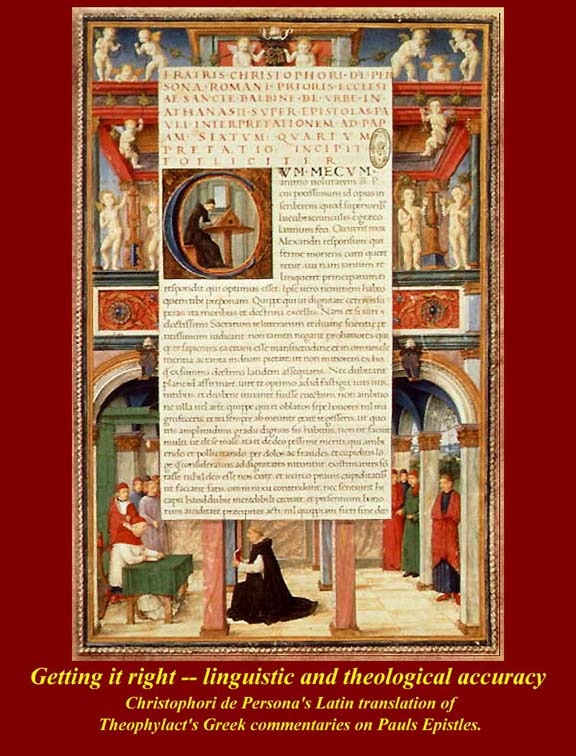
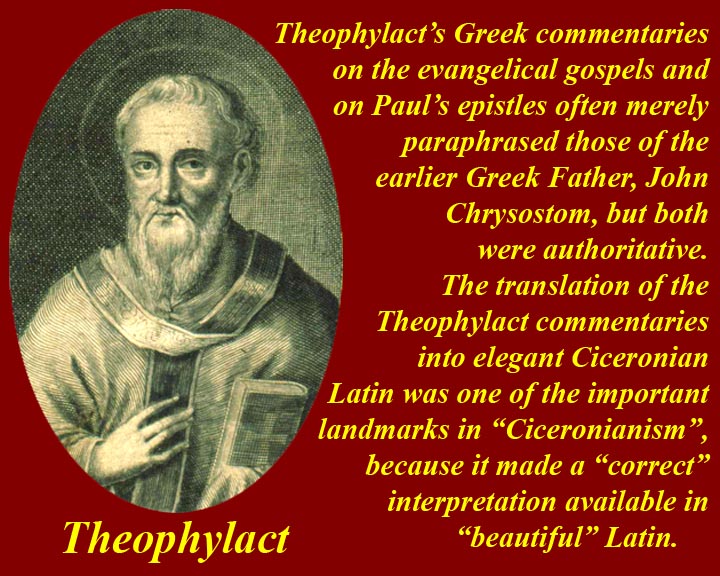
http://www.mmdtkw.org/RenRom0503-CorrectEloquent.jpg
http://www.mmdtkw.org/RenRom0503a-TheophylactTranslated.jpg
The Renaissance Humanists were infatuated with the idea of collating ancient non-Christian writings with supposed counterparts from the Christian biblical and patristic canon and with making everything available in correct and elegant Latin (and, of course, keeping everything in line with Christian dogma).
Theophylact's commentaries on Paul's writings were largely cribbed from similar commentaries by John Chrysostom, one of the "Greek Fathers" of Christianity. In fact, Theophylact's authenticity on Paul was considered to be proven by how well he he agreed with the "authoritative" works of his source, Chrysostom (who also commented on the Evangelical gospels). The problem, of course, was that both men wrote in Greek, and that the humanists wanted correct and elegant Ciceronian Latin translations. So they produced them.
The humanists not only translated Greek documents into Ciceronian Latin, they also translated non-Ciceronian Latin documents and Italian vernacular works into Ciceronian Latin. One of the notable books they worked up was Jerome's Vulgate Bible. The Vulgate is an early 5th-century Latin version of the Bible and is largely the result of the labors of Jerome, who was commissioned by Pope Damasus I in 382 to make a revision of the old Latin translations. By the 13th century this revision had come to be called the versio vulgata, that is, the "translation into common usage Latin", and ultimately it became the definitive and officially promulgated Latin version of the Bible in the Roman Catholic Church. Many supposed authoritative versions of the Vulgate, riddled with inconsistencies, were available by the time the first edition of the revised and corrected Sixto-Clementine Vulgate (the Biblia Sacra Vulgatæ Editionis Sixti Quinti Pontificis Maximi iussu recognita atque edita) was published by Clement VIII in 1592. There have been several revisions since, but most "Latinologists" agree that the lingua Latina of the Vulgate is still non-Ciceronian -- it's downright vulgar (meaning "of the common people, not the current meaning of "vulgar", which has diverged). See http://en.wikipedia.org/wiki/Vulgate and for a side-by-side comparison of "authoritative" Greek, English, and Latin Bible texts see http://www.newadvent.org/bible/gen001.htm. (Note that "authoritative" as used here really means current "Roman Catholic authoritative" -- we are, after all studying the Roman Renaissance.)
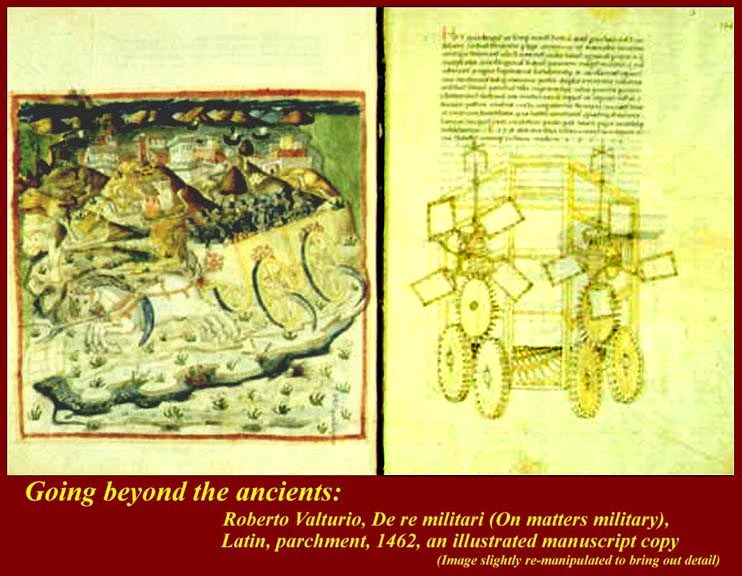
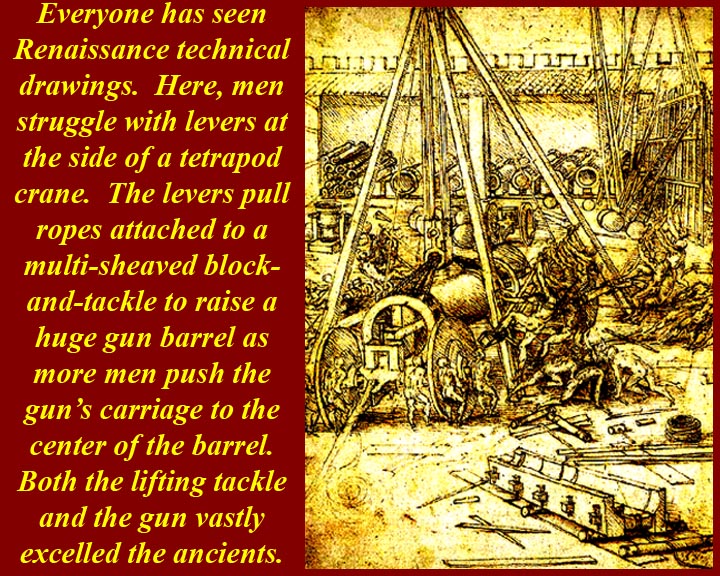
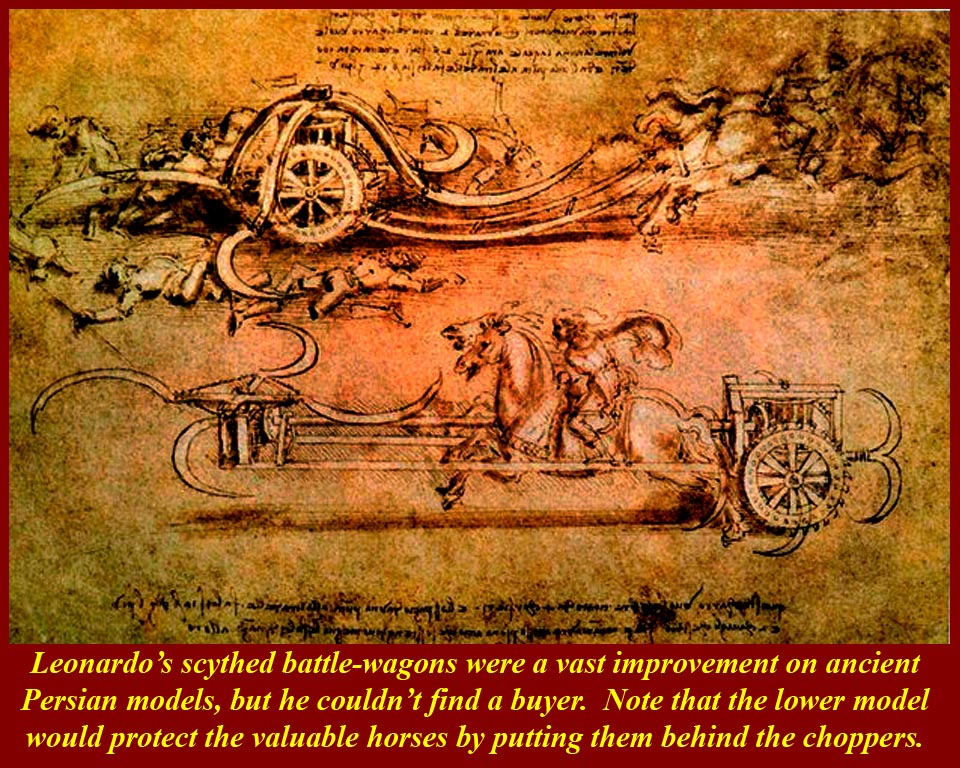
http://www.mmdtkw.org/RenRom0504-BeyondAncients.jpg
http://www.mmdtkw.org/RenRom0504a-ArtilleryArsenal.jpp
http://www.mmdtkw.org/RenRom0504b-DavinciScythedChariots1.jpg
http://www.mmdtkw.org/RenRom0504c-Weaponry.jpg
In addition to updating and "improving" ancient documents, humanist "Renaissance men" wanted to be artists, architects, and mechanical engineers. The engineering part was most often associated with design of weaponry to give their patron an edge in their constant warfare, but it could also be concerned with mills, with water movement (pumps and drains), or with construction equipment, especially for heavy lifting construction machines. All of this was considered to be part of the rebirth of ancient Rome, but Renaissance engineers wanted not just to equal ancient Roman accomplishments, but to surpass them in cleverness, in size, and perhaps even in usefulness. There were also new technologies to accommodate, and the most important of these was the use of explosive and incendiary powders, which had recently arrived from the orient. Gunpowder led to a race between explosive weapons (guns, rockets, mines, and mechanically delivered projectiles) and defensive fortifications.
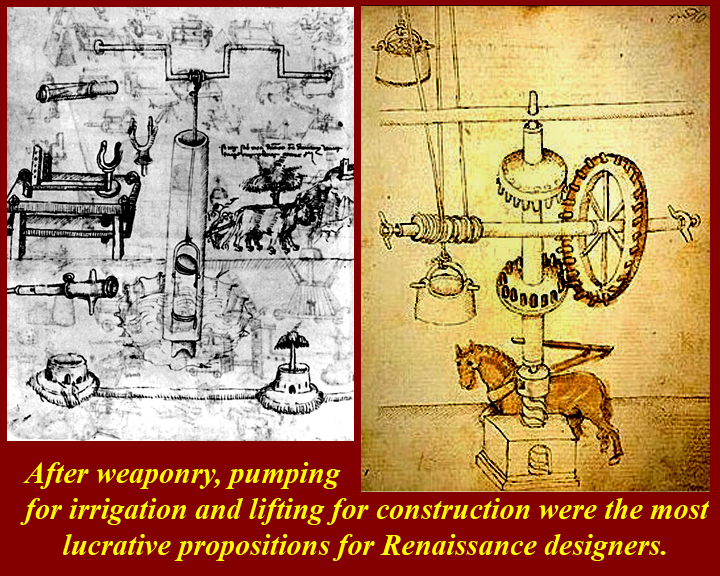
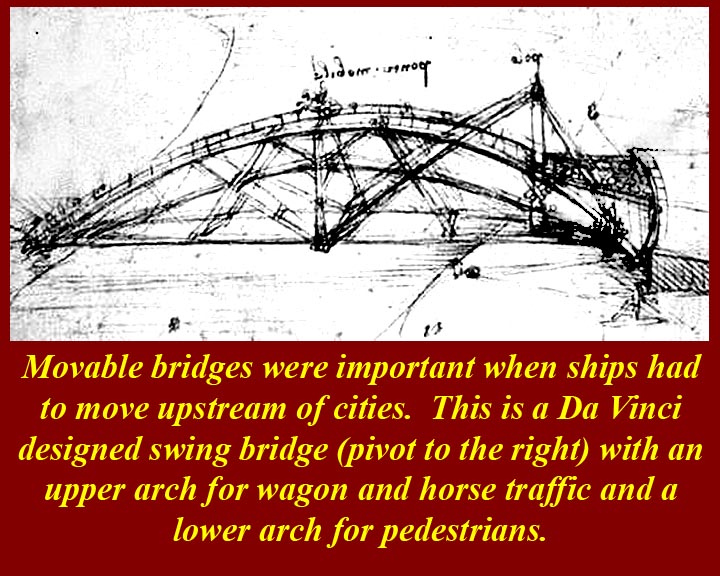
http://www.mmdtkw.org/RenRom0504d-PumpLift.jpg
http://www.mmdtkw.org/RenRom0504e-SwingBridge.jpg
http://www.mmdtkw.org/RenRom0504f-MartiniTreatise.jpg
Pumps, mills, bridges, and other non military mechanical devices all had one overriding purpose, the increase of wealth by the decrease of agricultural, manufacturing, or transportation costs. The most famous designer of such equipment during the Renaissance was -- no, not Leonardo, who we all know today from his ideas drawn in his notebooks but seldom brought to fruition -- no, it was a man named Francesco di Giorgio Martini, whose name is at the tip of nobody's tongue today.
Francesco was another Renaissance man -- painter, sculptor, architect, and military, civil, and mechanical engineer. The first six books of his Trattato di Architectura dealt with military and civil engineering. The seventh and last volume covered more prosaic mechanical devices and contains many small but clearly drawn images of cranes, mills, pumps, etc. (The whole work contains hundreds of such drawings.) What is important about Francesco is that, unlike Leonardo's, many of his devices came into common use. His disadvantage was that he was heavily plagiarized by more famous later men who took credit for his ideas. The plunder of his intellectual property must have begun during his own lifetime. Even though his Trattato was only circulated in a limited edition of manuscript copies, by the time he began writing the seventh book (20 years into his engineering literary project) he was lamenting in its prologue the plagiarism of his previous six books and the direct copying of his machines (ingengnio = engines) by
"...ignoramuses [who] adorn themselves with the labours of others and usurp the glory of an invention that is not theirs. For this reason the efforts of one who has true knowledge is often retarded. If in all epochs this vice has abounded, in our own it is more widespread than in any other."
And who were these usurpers? One of the men (it was always and only men) who got credit for Francesco's ideas was certainly Leonardo himself, although perhaps unwittingly and long after his own death. One of the few remaining manuscript copies of Francesco di Giorgio Martini's Trattato di Architectura has marginal notes in the distinctive handwriting of Leonardo -- he clearly once had the copy in his possession -- and several of Martini's drawings are copied uncredited into Leonardo's notes. Leonardo is today credited with these "invention".
Much of the information in this note and the partial Francesco quotation were derived from:
Francesco di Giorgio Martini's Treatise on Engineering and Its Plagiarists
by Ladislao Reti and Francesco di Giorgio Martini
Technology and Culture, Vol. 4, No. 3 (Summer, 1963), pp. 287-298
Published by: The Johns Hopkins University Press on behalf of the Society for the History of Technology.
The article also has pictures of Francesco's drawings and of the copies made by his plagiarists.
------- I wouldn't want to be accused of usurping! --TKW
You can have your own facsimile copy of Leonardo's copy of the Francesco di Giorgio Martini Trattato for only 1200 Euros (about $1740). Order from http://www.omifacsimiles.com/brochures/images/francesco.pdf.
http://www.mmdtkw.org/RenRom0504g-DaVinciAnatomical.jpg
If Leonardo's mechanical works were not all original, it is certain that his anatomical studies were his own. His human and animal life-studies have never been seen in works by earlier author/artists, and his studies of internal organs are definitely better than any contemporary and many later works. Leonardo clearly had access to body parts.
Printing press leads to wider readership
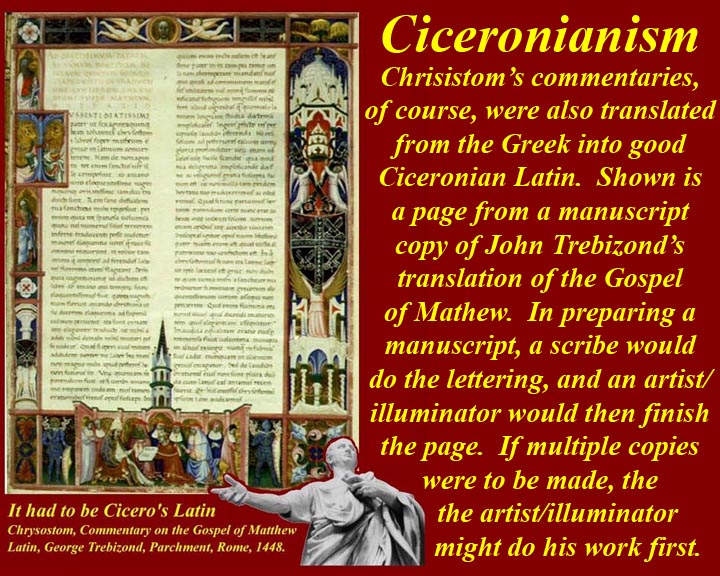
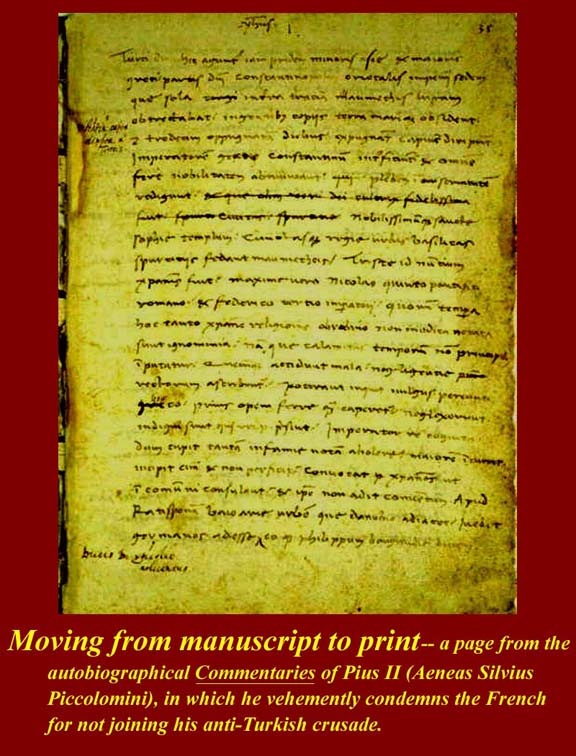
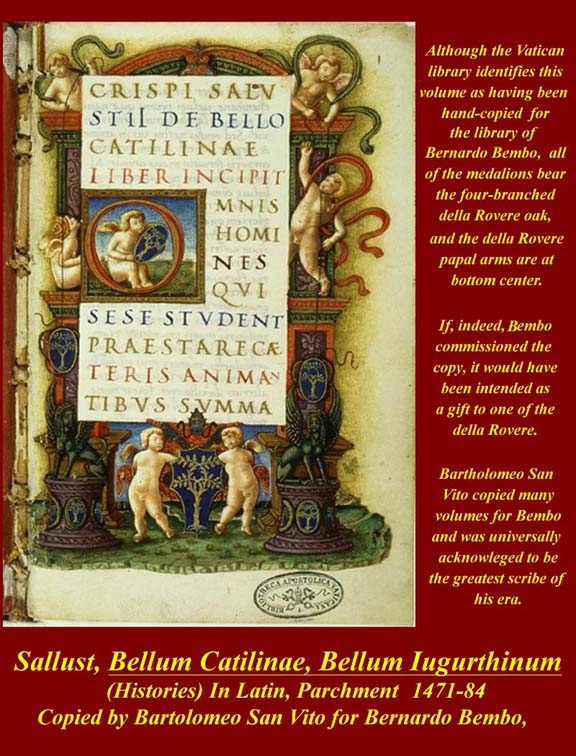
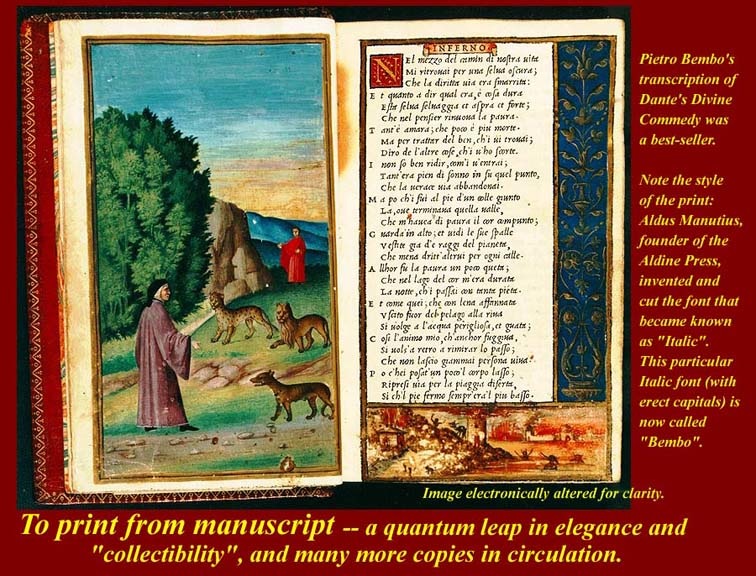
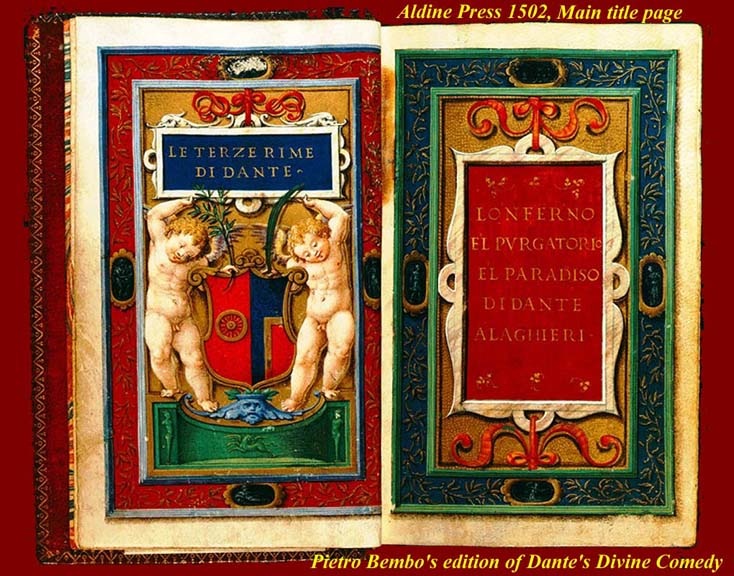
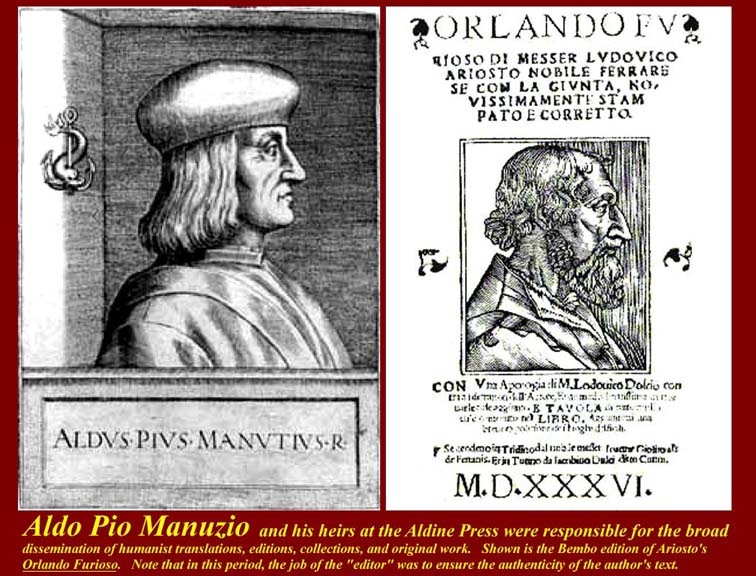
http://www.mmdtkw.org/RenRom0505-Ciceronianism.jpg
http://www.mmdtkw.org/RenRom0506-ManuscriptPrint1.jpg
http://www.mmdtkw.org/RenRom0507-ManuscriptPrint2.jpg
http://www.mmdtkw.org/RenRom0507a-AdventOfPrinting.jpg
http://www.mmdtkw.org/RenRom0508-ManuscriptPrint3.jpg
http://www.mmdtkw.org/RenRom0509-AldusBemboDante.jpg
http://www.mmdtkw.org/RenRom0510-AldoAldine.jpg
http://www.mmdtkw.org/RenRom0511-PrintingSpreads.jpg
At the beginning of the Roman Renaissance, only a few copies of original documents and translations from Latin and Greek could be disseminated in manuscript form -- literally hand written (Latin: manu, ablative of manus = by hand + scriptus, participle of scribere = written) by professional scribes. Works by individual scribes are often identifiable due to idiosyncratic styles (as is the case with document inscribed by Bartolomeo San Vito in the third image above), but just as often the scribe would proudly include his own name on the title page. By the end of the Renaissance, large printing houses were engaged in mass market distribution. Copyright did not really exist, although it might be a bit dangerous to steal from the bigger printing houses; their thugs might pay a visit to your shop and damage your presses if you stole too much. The bigger printers, on the other hand, stole with impunity from the smaller shops and from each other.
As printing spread, type "faces" had to be invented, and the most famous fonts were the Italics, which were carved by the workers of Aldo Pio Manuzio at his Venetian Aldine Press (founded in 1494). Among the Aldine Italic fonts was one called "Bembo", which was originally used exclusively for the works and translations of Pietro Bembo (1470-1547); it featured upright capital letters (or majuscule or upper case) and slanted small letters (or minuscule or lower case).
The papal curia's own printing house, now known as the Vatican Press but for several centuries known as the Propaganda Press -- i.e., the "Press for the Propagation of the Faith"-- wasn't founded until 1626. It is still responsible for all Vatican publications, and, theoretically, its parent organization, the curial "Congregation for the Doctrine of the Faith" (formerly known as the Inquisition) still has to give its permission (Latin: nihil obstat = "nothing stands in the way") and approval (Latin: imprimatur = "let it be pressed, i.e., impressed or printed") for all works printed and distributed by Catholic organizations world wide.
Before his election, Pope Benedict XVI, then Joseph Cardinal Ratzinger, was the head of the Vatican Press and Prefect of the Congregation for the Doctrine of the Faith, and he took great interest in new publications in Rome, often coming to initial book-signings to add his own prestige to the events. Pope Benedict also founded in November 2008 and is the patron of the Ratzinger Foundation, a charitable organization, which makes money from the sale of books and essays written by the Pope, in order to fund scholarships and bursaries for students across the world.
During the Second Vatican Council from 1962 to 1965, Ratzinger served as a peritus (theological consultant) to Josef Cardinal Frings of Cologne. He was viewed during the time of the Council as a reformer, cooperating with radical Modernist theologians like Hans Küng and Edward Schillebeeckx. Ratzinger became an admirer of Karl Rahner, a well-known academic theologian of the Nouvelle Théologie and a proponent of church reform.
In 1966, Joseph Ratzinger was appointed to a chair in dogmatic theology at the University of Tübingen, where he was a colleague of Hans Küng. In his 1968 book Introduction to Christianity, he wrote that the pope has a duty to hear differing voices within the Church before making a decision, and he downplayed the centrality of the papacy. During this time, he distanced himself from the atmosphere of Tübingen and the Marxist leanings of the student movement of the 1960s; despite his reformist bent, his views increasingly came to contrast with the liberal ideas gaining currency in theological circles. Some voices, among them Hans Küng, deemed this a turn towards Conservatism, while Ratzinger himself said in a 1993 interview, "I see no break in my views as a theologian [over the years]". Ratzinger has continued to defend the work of the Second Vatican Council, including Nostra Aetate, the document on respect of other religions, ecumenism and the declaration of the right to freedom of religion. Later, as the Prefect for the Congregation for the Doctrine of the Faith, Ratzinger most clearly spelled out the Catholic Church's position on other religions in the 2000 document Dominus Iesus which also talks about the Roman Catholic way to engage in ecumenical dialogue.
Neo-Latin poetry -- New works in Ciceronian Latin
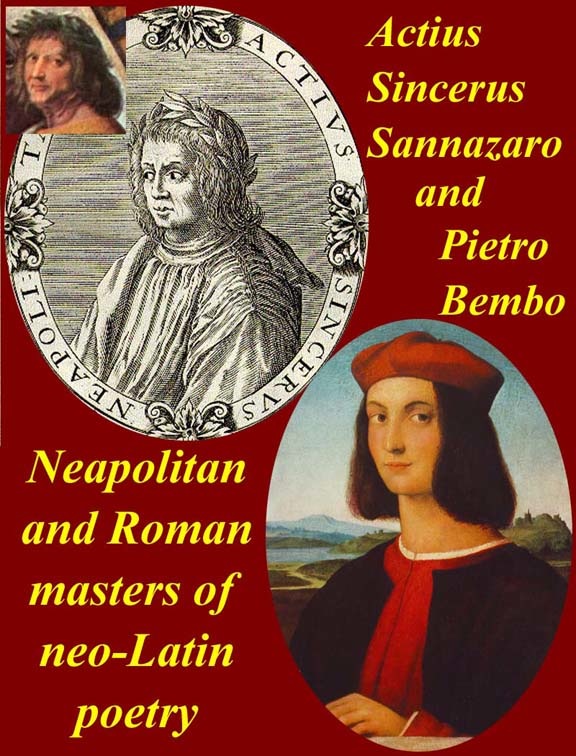
http://www.mmdtkw.org/RenRom0512-NeoLatinPoetry.jpg
http://www.mmdtkw.org/RenRom0512a-PietroBembo.jpg
After cutting their teeth on translating the ancients, some humanists began to emulate the ancient Latin Poets by writing "neo-Latin" poetry. The two greatest exponents of neo-Latinism were Actius Sincerus Sannazaro, pictured as the Poet Laureate of Naples. and Pietro Bembo of Rome. Bembo's early poems were modeled after the physical/sexual love poetry of the ancient Roman poets Catullus, Propertius, and Ovid, and, as might have been expected, his work was condemned by the church. But times and Bembo changed; he was a favorite of the Medici and was secretary to Pope Leo X Medici. He was made a cardinal in 1539 by Pope Paul III Farnese and for the remaining eight years of his life wrote almost entirely on religious subjects. He died at age 77.
Bembo was for many years the arbiter of Italian letters, insisting that classical traditions be preserved. He was responsible for editions of Petrarch and Dante and helped establish the language of Tuscany as the standard of literary Italian. He wrote the History of Venice (1551); a disquisition on platonic love, Gli Asolani (1505, tr. 1954), inspired by Plato's Symposium; a book of lyric verse (Rime, 1530) in Latin and Italian; and Prose della volgar lingua [prose in the vernacular] (1525). See http://en.wikipedia.org/wiki/Jacopo_Sannazaro and http://www.newadvent.org/cathen/13449d.htm for Sannazaro, and see http://en.wikipedia.org/wiki/Pietro_Bembo and http://www.newadvent.org/cathen/02425e.htm for Bembo.
From Greek to Ciceronian Latin -- Bessarion as translator
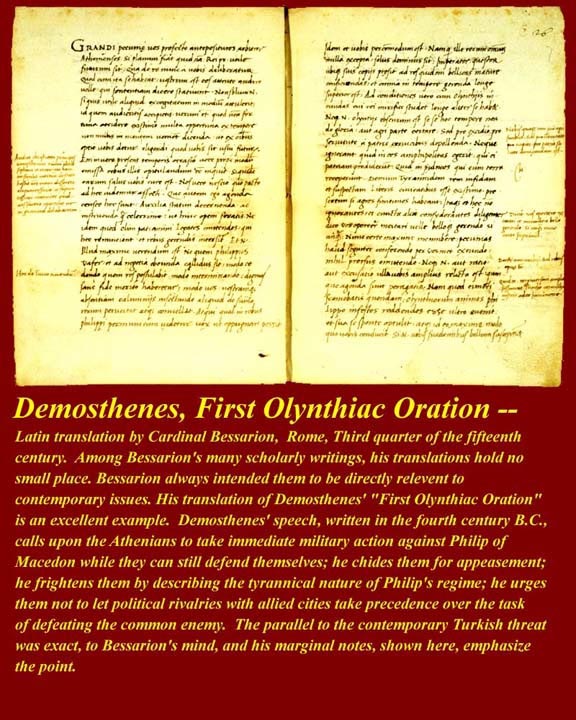
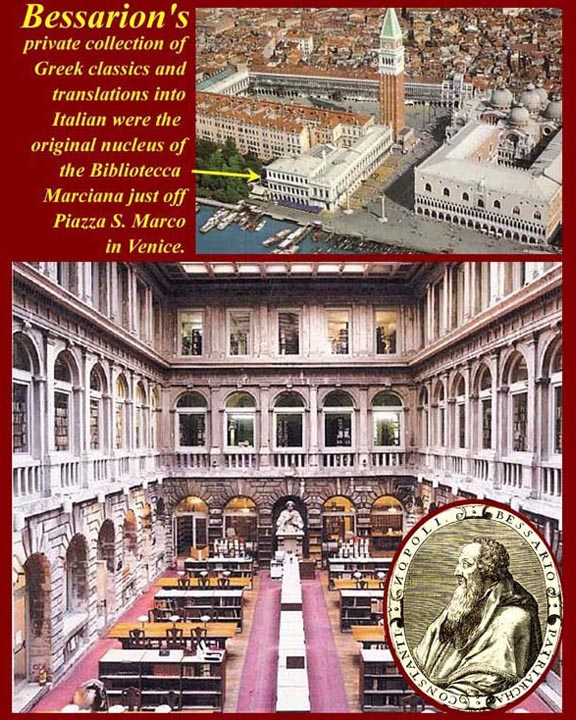
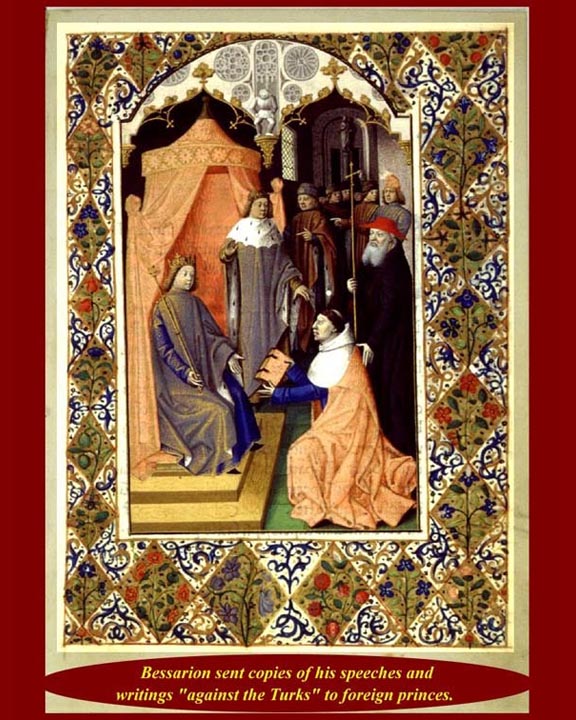
http://www.mmdtkw.org/RenRom0513-BessarDemosthene.jpg
http://www.mmdtkw.org/RenRom0514-BessarioMarciana.jpg
http://www.mmdtkw.org/RenRom0515-BessarContraTurk.jpg
Bessarion donated his collections to the Marciana (St. Mark's) library in Venice. Still an unmatched source for Greek classics and their translations. Bessarion's other issue (i.e., besides dissemination of Greek Classics): confronting Turkish Expansion -- correspondence with European princes (essentially a failed issue.)
Writing in the shadows -- pseudonymous humanist authors
http://www.mmdtkw.org/RenRom0516-Palingenius.jpg
Mysterious Palingenius -- Writing under a pseudonym to avoid the inquisition, the true identity of Palingenius was not discovered during his lifetime -- and perhaps was never discovered. The inquisition finally found what they said was an anagram in the initial letters of a Palingenius document and identified Pierangelo Manzolli as its author. But Manzolli was already dead and buried. No problem -- the inquisition dug him up and burned his bones.
Palingenius wrote Zodiacus Vitae, a Latin poem divided into 12 books, one for each sign of the zodiac, one edition of which was published at Basel in 1543, but first published perhaps as early as the early 1430s. It was dedicated to Ercole II d'Este, duke of Ferrara. The didactic poem addresses the subject of human happiness in connection with scientific knowledge, and combines metaphysical speculation with satirical attacks on ecclesiastical hypocrisy, and especially on the Popes and Martin Luther. It was translated into several languages, but fell under the ban of the Inquisition on the ground of its rationalizing tendencies. After Manzolli's death, the Catholic Church burned his "heretical" bones and Pope Paul IV placed his book in the first Index Librorum Prohibitorum in 1559.
"The first official censorship had come in 1559 with the publication of the Index auctorum et librorum prohibitorum under the direction of Pope Paul IV. The Pauline index, as it became known, was the first in a long succession of papal indexes, forty-two in all. The purpose of these indexes was to guide censors in their decisions of what publications to authorize and which to disallow, for printers were not free to publish books without official permission. In January of 1562 the Council of Trent took up the issue of the Index and was deeply divided. The Pauline index had been seen by many as too controversial and excessively restrictive. After the opening speeches, the council appointed a commission to draft a new index. Although the council closed before the task of the commission was completed, the new Tridentine index was taken up by Pope Pius IV and published in 1564 by Paulus Manutius in Rome. This index constituted the most authoritative guide the church had yet published; its lists formed the basis of all subsequent indexes, while its rules were accepted as the guide for future censors and compilers."
From http://sourcebooks.fordham.edu/halsall/mod/indexlibrorum.asp (quoting a now lost link http://library.lib.byu.edu/~aldine/51Index.html)
Writing in the shadows -- forgotten authors
http://www.mmdtkw.org/RenRom0518-RaphMaffei.jpg
Raffaelo Maffei is the poster-boy for Renaissance humanists that were not notorious. Although very famous in his own day for his works and translations, he, and many others, were quickly forgotten: no scandal, so no lasting fame.
Writing in the shadows -- women poets
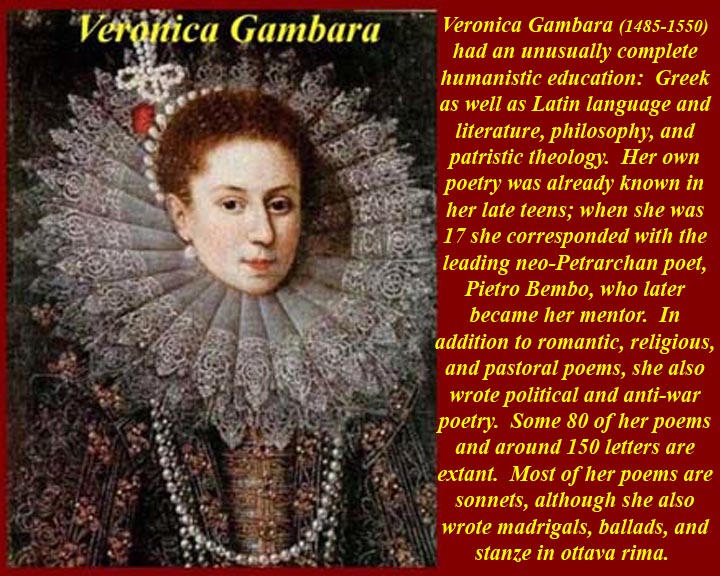
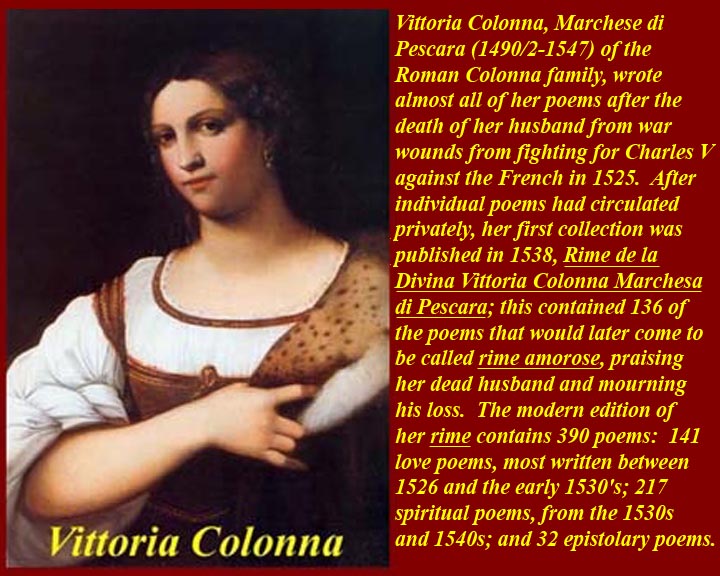
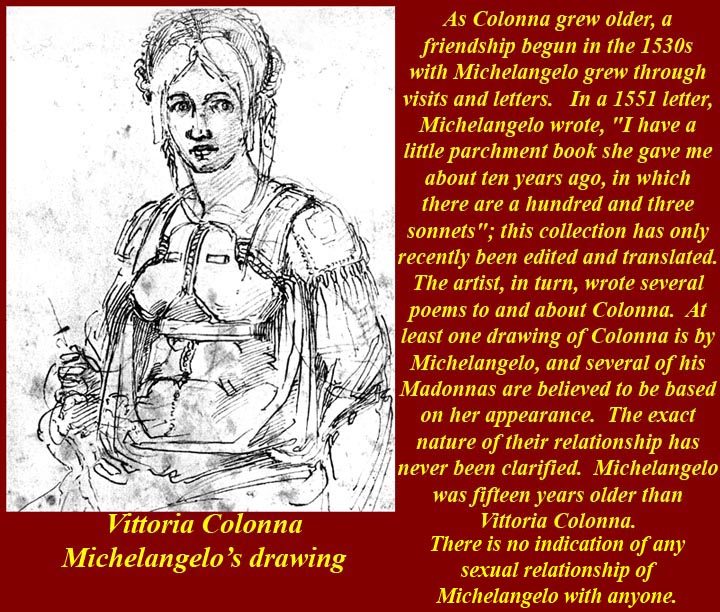

http://www.mmdtkw.org/RenRom0519-PoetessGambara.jpg
http://www.mmdtkw.org/RenRom0520-PoetessVittoriaColonna1.jpg
http://www.mmdtkw.org/RenRom0520a-MichelangeloVittoriaColonna.jpg
http://www.mmdtkw.org/RenRom0520c-ToVittoriaColonna.jpg
http://www.mmdtkw.org/RenRom0521-PoetessFranco.jpg
Women participated too. Veronica Gambara, Vittoria Colonna, and Veronica Franco -- two noblewomen and a courtesan are noted Renaissance poetesses.
Veronica Gambara tried --- for her own reasons --- to be a peacemaker. Her first concern were her sons and Correggio, the territory she inherited from her husband, and she had friends and relatives throughout northern Italy. She knew and liked Francis I; she admired (and came to know) Charles V; she had friends close to the pope. She addressed a number of her poems to whoever could contribute to the peace of the territories she loved. Of Gambara's writings some 80 poems and around 150 letters are extant. Most of her poems are sonnets, although she also wrote madrigals, ballads, and stanze in ottava rima. Besides her political poems, she wrote poems of love, religious devotion, and pastoral praise of Brescia and Correggio. There is no complete English translation of her poetry or correspondence, but the majority of her poems are now available online, and some poems and letters are available in print.
After individual poems had circulated privately, Vittoria Colonna's first collection was published in 1538, Rime de la Divina Vittoria Colonna Marchesa di Pescara; this contained 136 of the poems that would later come to be called rime amorose, praising her dead husband, Ferrante Francesco d'Avalos, Marquis of Pescara, and mourning his loss. But in an edition of the following year, 16 "sonetti spirituali" were advertised, and later editions included an ever-increasing number of rime spirituali, reflecting the shift of Colonna's focus. These editions were published apparently without Colonna's approval, and the arrangement of the poems were the editors. The modern edition of her Rime contains 390 poems: 141 love poems, most written between 1526 and the early 1530's; 217 spiritual poems, from the 1530s and 1540s; and 32 epistolary poems. Vittoria Colonna appears to have had a Platonic relationship with Michelangelo -- a man who appears to have had only that kind of relationship. Some modern psychologists seem to think Michelangelo was a repressed homosexual, although they admit they have little or no evidence that that was the case. Michelangelo wrote at least one sonnet to Colonna after her death, and several more of his poems may also have been for her.
Only Veronica Franco is remembered today -- and wildly inaccurately due to a movie called Dangerous Beauty, which the producers said was based on a fairly accurate study of Franco called The Honest Courtesan. The producers misrepresented the case, but the book went to the best-seller list, so the author, Margaret F. Rosenthal, shouldn't be to unhappy. But the movie, although it inaccurately portrays Franco, has wonderful costumery, background shots (Venice), and cinematography. It's good in the way that the Gladiator movie is -- little fact, but plenty of accurate atmospherics and good fun.
For information on Veronica Gambara, see https://en.wikipedia.org/wiki/Veronica_Gambara and http://www.jimandellen.org/gambara.biography.html. C.f., http://www.jimandellen.org/ellen/emschol.htm for some of her poetry.
For information on Vittoria Colonna, see http://www.lib.uchicago.edu/efts/IWW/BIOS/A0011.html and http://www.lib.uchicago.edu/efts/IWW/Portraits/HTML/A0011.html, which includes a painting of Michelangelo at her catafalque. C.f., http://www.jimandellen.org/ellen/emschol.htm for some of her poetry.
For information on Veronica Franco, see http://www.lib.uchicago.edu/efts/IWW/BIOS/A0017.html and http://en.wikipedia.org/wiki/Veronica_Franco. For a trailer for Dangerous Beauty, see https://www.youtube.com/watch?v=xYu37jF0d3c. English translations of poems by and to Veronica Franco are available at http://thepoetsgarret.com/franco/franco.html.
For information on Italian women authors, some of whom wrote during the Italian Renaissance, see https://en.wikipedia.org/wiki/List_of_Italian_women_writers.
Ephemera
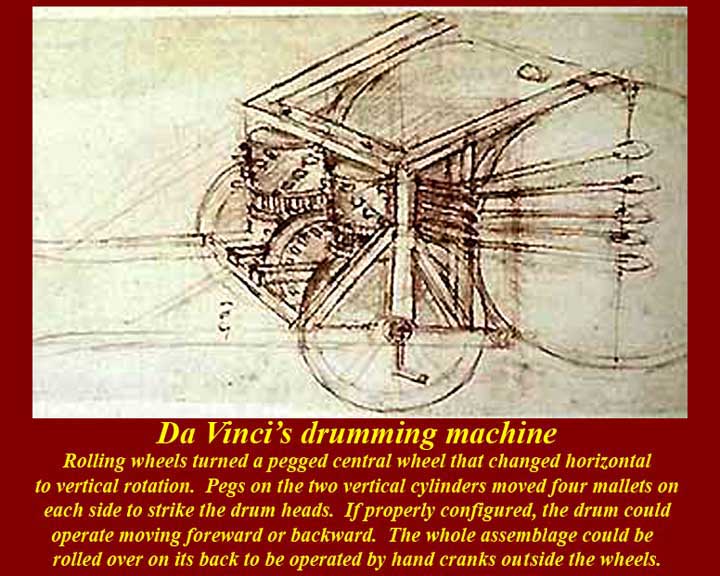
http://www.mmdtkw.org/RenRom0522-DrumMachine.jpg
http://www.mmdtkw.org/RenRom0523-AnimusicDrumMachine.jpg
Not every machine designed during the Renaissance had a practical use. A favorite, even if it never was built, is Leonardo's rolling drum machine. Eight mallets, four per side, struck the two drum heads as the machine rolled along. It could also be rolled over like a turtle on its back and be operated by two hand cranks. A newer drum machine drawing (Animusic - "Drum Machine" -- Image copyright © 2004-2006 Animusic) is shown for comparison. See https://www.youtube.com/watch?v=F7tMuUekYQA see the modern drum machine animated. The Animusic internet home page is at http://www.animusic.com/index.php. C.f., https://www.youtube.com/watch?v=IvUU8joBb1Q.

